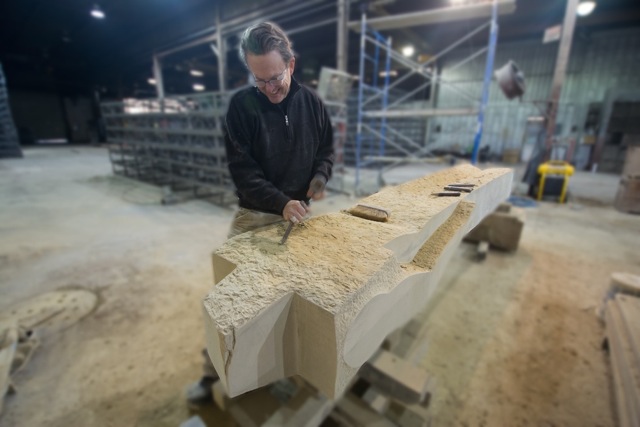
Of all the stonework I do, my commissioned sculptural works have proven to be the most rewarding, and my clients invariably speak lyrically of the process. Commissioning and fashioning a unique work of art involves personal, collaborative investments of time, taste, trust and talent. From excited conceptual beginnings to gratifying final installations, commissions follow a complex sequence of milestones. These steps may be unfamiliar to clients, but due to my past experiences, I more than happy to be a guide.
The beginning of everything is the client’s vision, however rough, however refined. whether shape or space, architectural or natural, the client’s vision is the impetus for what we would like to memorialize in stone. At this point is where I step in. While it is true that every commission is unique, all usually go through the following eight essential stages of design and budgeting, sculpting and installation:
The “call”: Typically, a client initiates a discussion with an initial idea or location where a work of art might reside. This initiates a collaborative process that assumes I’m being hired for my unique vision and abilities. The client’s concept acts as the starting point for a much longer process, one of discovery and invention, which is ultimately driven by the artist.
Site visit: The artist will visit the site that the sculpture will occupy, meet with all interested parties, take measurements, and record site information and initial impressions. After the site visit, the artist will put together a design proposal for initial conceptual development of the work. Typically, 50% of proposal development costs are paid before proceeding further.
Concept presentation: The initial concepts are presented. This may be one or multiple possibilities, at the artist’s discretion. Basic material choices may be included in this process. Feedback on the concept and direction are solicited and budget ranges are discussed.
Concept Refinement: Feedback from the initial presentation is incorporated into a second presentation.
Budgeting: Once the concept is fully defined, with scale and rough dimensions determined, the larger budgeting can be completed. This typically ends the initial concept development proposal phase, and at this point the other 50% of the initial contract costs are due. As is standard in the industry, Rhodes’ designs remain the property of the artist and may not be built by others without express permission.
Prototypes: Once the budget has been accepted, new contracts are engaged for the final sculpture and the work goes into production. This typically starts with a model at reduced scale. If the work is more architectural, a full-scale mock-up showing a representative corner is produced. The model / mock-up presentation is one of the high points of the commission process, since the ideas become reality for the first time. Not everyone can visualize from drawings, so putting the work into three dimensions is essential. Clients often enjoy visiting the studio during the model-making process. For architectural commissions, completion of the full-scale mock-up begins a final round of budgeting and construction contracts.
Sculpting the Stone: Once the model is approved, the work enters into production. This phase may take a relatively long time, since carving stone and assembling a work goes slowly. Clients visiting the studio are sometimes taken aback to discover only incremental progress over weeks or months of the artist working with hand tools to unlock the expressive potential of the stone medium. When viewed against the backdrop of the works’ longevity (granite weathers one inch in ten thousand years), this time is well spent.
Once the sculpture is completed, a (usually festive) “unveiling” of the finished work for the client and project team ends the carving stage and contract.
Installation: Moving the finished work into position requires great skill, planning and preparation. This last stage is typically contracted separately, after the other work has been completed and any complicating site factors identified.
Clients have regularly remarked at the conclusion of sculpture commissions that the process has been one of the “great creative experiences of their lives.” It offers an intimate view of the creative process, so often hidden behind galleries and museum presentations where the work only exists in a completed and static state. The ability to participate and influence the tens of thousands of small decisions that are involved in bringing a work of art into being is a privilege clients invariably come to cherish.